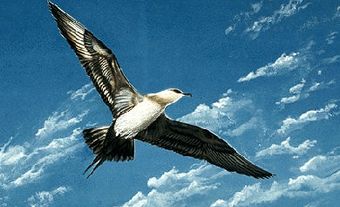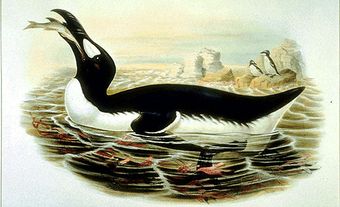Auks or Alcids refers to birds of the taxonomic group Alcidea. Alcidae is a family within the order Charadriiformes of highly specialized seabirds that contains auks (including the now-extinct great auk), auklets, murres, murrelets, razorbills, dovekies, guillemots and puffins.
Description
Alcids are diving birds which pursue small fish and invertebrates by "flying" underwater. They have a chunky appearance and are 12-43 cm long and 140-1,100 g in body weight. Their plumage is typically black or dark grey above and white underneath. Their wings and tails are short; their legs are placed far back for swimming.
Species in Canada
The 24 living species of this ancient and diverse group occupy a unique niche in nearshore and offshore northern polar and temperate waters. Of the 22 species breeding in North America, 13 breed in Canada. The common and thick-billed murres (Uria aalge and U. lomvia) breed in the Atlantic and Pacific oceans; dovekies (Alle alle), razorbills (Alca torda), black guillemots (Cepphus grylle) and Atlantic puffins (Fratercula arctica) in the Atlantic and parts of the Arctic Ocean; pigeon guillemots (C. columba), marbled and ancient murrelets (Brachyramphus marmoratus and Synthliboramphus antiquus), Cassin's and rhinoceros auklets (Ptychoramphus aleuticus and Cerorhinca monocerata) and horned and tufted puffins (F. cirrhata and F. corniculata) breed in the Pacific. Four other species are nonbreeding visitors: Xantus' murrelet (S. hypoleucus), parakeet (Cyclorrhynchus psittacula) and least and crested auklets (Aethia pusilla andA. cristatella).
Reproduction
Alcids come ashore only during the breeding season. Most species are colonial and breed at a few coastal sites (often islands), which are free of predators and near an adequate food supply. Long-lived birds, alcids breed for the first time at 4-5 years and typically lay only one egg annually. Depending on the species, the egg is laid on exposed ledges on steep sea cliffs, in rock crevices or between large boulders, in burrows or open ground, and, exceptionally, on branches high in trees. Both parents incubate the egg and rear the young; incubation and chick-rearing usually last a total of 10 weeks.

 Share on Facebook
Share on Facebook Share on X
Share on X Share by Email
Share by Email Share on Google Classroom
Share on Google Classroom









